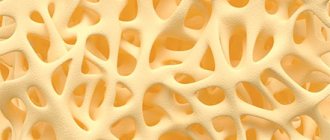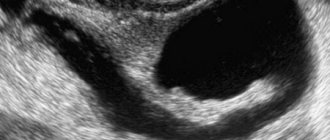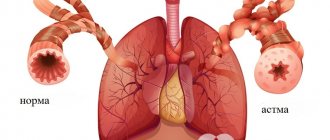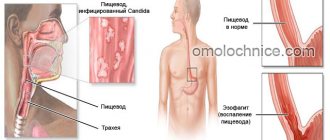What is it - vaginal candidiasis
This is an infection caused by the penetration of spores of yeast-like fungi of the genus Candida into the vaginal mucosa. You can “catch the infection” through sexual contact or lack of personal hygiene (for example: dirty objects, fecal residues from the rectum).
As a result of fungal growth and spread, a painful condition develops, in other words, thrush. Candida, multiplying in the vagina, can smoothly flow to the mucous membrane of the cervix and vulva.
Vaginal candidiasis occurs mainly in young people. Girls usually have bad luck before their period. Ladies who are expecting a child suffer from this disease even more often. Women over forty-five years old have practically none.
Like any disease, vaginal candidiasis has its own forms:
- carrier status;
- true candidiasis (illness period of one to two months);
- Chronic candidiasis (lingers for three months or more).
Types of thrush
In gynecology, vulvovaginal candidiasis is diagnosed and treated mainly. But yeast-like fungi can spread to other mucous membranes:
- in the intestines;
- in the oral cavity;
- urethra
In severe cases, damage to the skin and internal organs is possible.
Candidal vaginitis can be acute and chronic, recurrent. The acute form is characterized by severe symptoms and copious discharge from the genitals. If left untreated, thrush becomes chronic with sluggish symptoms.
The recurrent form of the disease occurs against the background of infection of the vagina and intestines. After treatment with a local drug, fungi migrate back into the genital tract and provoke the appearance of acute symptoms. Relapses occur when the immune system is weakened, hormonal changes during menstruation, or pregnancy.
https://youtu.be/3LkuP16M5XA
Signs of thrush in women
The proliferation of candida is complemented by a general weakening of the body (due to toxins produced by fungi). This provokes inflammation. The mucous membrane intensively begins to get rid of the damaged layer. As a result, the ladies notice:
- “harassing” itching in the vagina and vulva, especially at night;
- specific discharge - leucorrhoea, which looks like crumbs of cottage cheese, sometimes whitish, yellowish or greenish;
- “smell” reminiscent of sour kefir;
- Some people experience a burning sensation and pain when walking “in a small way.”
Important! Vaginal candidiasis can be chronic. An itchy vagina in this case may be the only inconvenience for a sick woman. Itching intensifies after intimacy or before the onset of menstruation.
I would especially like to touch upon pregnant women, who already have enough worries, and then there’s this “grief.” Against the background of restructuring of the body for the full bearing of the baby, various changes in hormonal processes, metabolism and a decrease in the level of immunity occur. Well, a fungal infection is right there. The time has come for her to “bloom.”
The nature of vaginal candidiasis in expectant mothers is rapid, with all the “attractions”, that is, itching and “curdling”. If the number of thrush fungi begins to go off scale, then they will be able to break through to the uterus and into the amniotic fluid.
However, there is no need to grieve in advance; such agility of the fungus is not enough to infect an unborn baby. The uterus is designed in such a way that at critical moments it can cleanse itself. The baby can “pick up” the sore more likely during childbirth, when he moves along the affected birth canal of his mother. Pediatricians, in this case, talk about the possibility that the child will develop an intestinal disorder, inflammation of the oral mucosa, and even inflammation of the ear. The fungus can manifest itself wherever there has been direct contact with infectious waters.
I would like to give practical advice! Do not self-medicate under any circumstances and if you suspect vaginal candidiasis, consult a doctor immediately. Only a gynecologist will be able to give you comprehensive information about the methods of treating your disease.
Symptoms and signs
Vivid symptoms are characteristic of vulvar candidiasis. The photo below proves this.
The main symptoms of the disease include:
- Redness of the mucous membrane in the area of the labia minora and the vestibule of the vagina, their swelling;
- The appearance of a white coating;
- A burning sensation and severe itching in the external genital area, especially after exposure to soap and water, when urinating;
- Women experience pain during sexual intercourse.
In rare cases, there is an increase in temperature and enlargement of the inguinal lymph nodes. In chronic candidal vulvitis, the symptoms are the same as in the acute period, but they are less pronounced and tend to recur after some time. The chronic form recurs up to 5 times a year.
Diagnostic measures
Often thrush is associated with an infection caused by bacteria. And the “victim,” along with treatment for candida, also has to be treated with antibiotics. To fully confirm the diagnosis and prescribe the correct treatment, you will have to take a smear and undergo a medical examination by a specialist.
A smear to confirm and determine the type and number of fungi is taken by a health worker in a clinic setting. If you are scheduled for a test, you must purchase a disposable sterile gynecological kit with a cytobrush in advance. Vaginal secretions are spread onto a glass slide and then placed under a microscope. Using this analysis, you can determine the degree of damage to the body.
In addition, as prescribed by your doctor, you may need to culture the secretions on a nutrient medium (to determine the sensitivity of the infection to certain medications). This manipulation will give a final answer to the question of what is the best way to treat you.
Most likely, you will also have to undergo a general blood and urine test.
Diagnostics
To make a diagnosis, it is necessary to take an anamnesis and conduct an examination of the patient. Since the external signs of candidiasis may be similar to other infectious diseases, an external examination is not enough.
- When performing colposcopy after Lugol staining, small inclusions in the discharge with a visible vascular pattern are observed. Chronic candidiasis is characterized by secondary inflammation - atrophic changes in tissues, their infiltration.
- The most informative method for determining thrush is microscopy. Gram staining of a vaginal smear reveals Candida spores and pseudomycelia.
- Additionally, inoculation is carried out on artificial nutrient media (Saburo, blood agar). Culture can determine the type of fungus and its sensitivity to antifungal drugs.
Additionally, the following may be prescribed: tests for the presence of sexually transmitted infections; intestinal microbiocenosis; glycemic profile analysis.
How to properly treat vaginal candidiasis
Preserving and strengthening women's health is the most important direction in the development of modern medicine. A healthy woman means a healthy family, healthy children, and therefore a healthy nation.
A vagina affected by candida is treated by a gynecologist. What is important here is adherence to the treatment period, a variety of dosage forms, and dosage.
An integrated approach will ensure the effectiveness of the therapy. You girls will have to take pills and use suppositories. Don't forget about personal hygiene. But this does not mean that you should endlessly wash (and God forbid, douche!) your intimate area. According to doctors, douching is not in fashion these days - it is ineffective and inconvenient.
Modern medicine offers a wide selection of medicinal antifungal medications in various forms. Candidiasis can be easily cured with vaginal suppositories. In a short time, all symptoms will go away and you will be able to live a normal life.
Important! If the candles are chosen incorrectly, they can have the opposite effect. Some negatively affect the baby while still in the womb. Timely consultation with a doctor is extremely important.
Effective pharmaceuticals:
- Miconazole. A vaginal suppository that combines both antifungal and antimicrobial “blow”. Treatment is prescribed for at least two weeks. And one dose per day.
- Clotrimazole. Candles that are most active against yeast-like and moldy fungi and many bacteria. Used once a day, period - from three days to a week.
- Pimafucin. One of the highest quality drugs that has a therapeutic effect not only against fungi, but also to a large extent against bacteria (as it contains a strong antibiotic). The suppository is inserted into the vagina. The course of treatment is from three to six days. The main difference from other “products” is that it is indicated for pregnant and breastfeeding women.
- Hexicon. Acts against thrush as a “disinfectant weapon.” Candida infection disappears within a period of one to three weeks, with a single application per day. But, be careful! Menstruation or allergies to the components of the drug are a contraindication.
- Livarol. The activity of the suppositories is expressed in an intense anti-candidiasis effect. Apply once a day. The duration of treatment is from three to ten days. Prohibited for use in the first months of pregnancy!
How to insert suppositories correctly:
- First, before the manipulation, wash yourself in the shower and go to the toilet. Using clean hands, quickly remove the candles from the shell, as the cocoa butter contained in the “rocket” will begin to melt.
- Secondly, in order not to stain your clothes, it is best to insert the drug when you go to bed. The suppository should be in the vagina deeply and for a long time. The substances inside the suppository are slowly absorbed through the mucous membrane.
Do not rush when introducing the candle, but do not hesitate either, try to do everything clearly and correctly.
https://youtu.be/1Hl_LcM3J10
Treatment of thrush: methods and effective drugs
- Prohibition on self-medication. Based on the results of the examination, the doctor will select a drug to which the causative fungus is sensitive, and the optimal dosage of the drug.
- Completing the full course of treatment. Therapy interrupted prematurely may be ineffective.
- Sexual rest for the duration of treatment.
- Measures to strengthen immunity.
- A course of probiotics to restore vaginal microflora. During treatment with antibiotics, it is also recommended to take fermented milk products containing bifidobacteria and probiotics. They replenish the supply of “good” microorganisms and improve digestion, preventing the occurrence of fungal infections.
Depending on the causative agent of candidal vaginitis, the attending physician prescribes medications from various groups. If the cause of vaginitis is only a fungus, they resort to therapy with antifungal suppositories and creams or a single dose of medication in the form of tablets. For mixed infections, antibiotics are prescribed simultaneously with fungicidal drugs or combined agents.
Treatment must be comprehensive. It includes:
- combating the root cause of the disease (drug treatment);
- taking medications that stimulate the immune system and support beneficial microflora;
- herbal medicine;
- taking vitamins.
| Group of drugs | A drug | Dosage/frequency, once a day | Course of treatment, days | Release form |
| Antifungal drugs | Clotrimazole | 1%/1 | 7-14 | cream |
| 100mg/1 | 7 | vaginal tablets | ||
| 200mg/1 | 3 | |||
| 500mg | once | |||
| Miconazole | 2%/1 | 7 | cream | |
| 100mg/1 | 7 | vaginal tablets | ||
| 200mg/1 | 3 | |||
| Hexicon | 16mg/2 times a day | 7-10 | suppositories, vaginal tablets, gel | |
| Metronidazole | 500mg/1 | 10 | ||
| Ornidazole | 500mg/2-4 | 5-7 | vaginal tablets, oral capsules | |
| Polyene antibiotics | Nystatin | 100mg/1 | 7 | vaginal tablets |
| Levorin | 250mg/2 | 14 | candles | |
| 500mg/2-3 | 10-14 | tablets orally | ||
| 5%/2 | 10-14 | ointment | ||
| Mycoseptin | 4-6 weeks | ointment | ||
| Amphoglucamine | 100mg/2-5 | 10-14 | tablets orally | |
| Combined preparations based on an antifungal agent and an antibiotic | Terzhinan | 100mg/1 | 10 | vaginal tablets |
| Ginalgin | 100mg/1 | 7-10 | ||
| Polygynax | 100mg/1 | 12 | candles | |
| Triazole derivatives | Fluconazole (Diflucan) | 150mg | once | tablets orally |
After completing the course of treatment, it is necessary to undergo repeated tests to confirm recovery.
Complex treatment of vaginal candidiasis includes exposure to the causative agent - Candida fungi, elimination of provoking factors, and treatment of concomitant pathologies.
For vaginal candidiasis, various groups of antifungal agents are used systemically and locally: polyene antibiotics (nystatin, natamycin), imidazole and triazole antimycotics (clotrimazole, ketoconazole, fluconazole, itraconazole). Fluconazole, which has a wide spectrum of fungistatic effects and does not have side effects on steroid synthesis and metabolism, shows good results in the treatment of vaginal candidiasis. The effectiveness of a single oral dose of a high dose provides an advantage over other antimycotics.
For mild cases, local medications (miconazole, clotrimazole) in the form of cream, vaginal suppositories and tablets are indicated. For chronic infection, systemic antifungal drugs are repeated in certain courses. It is preferable to prescribe low-toxic forms of antimycotics for pregnant women (natamycin, nifuratel intravaginally) and in childhood (nifuratel in applications and intravaginally, fluconazole orally).
Therapy of vaginal candidiasis can be supplemented by local use of disinfectants and anti-inflammatory agents - solutions of borax in glycerin, potassium permanganate and silver nitrate in the form of baths and douches. For vaginal candidiasis of polymicrobial origin, combinations of antimycotics with metronidazole are prescribed. Immunity is corrected with immunostimulating agents, and multivitamins are indicated. Cure from vaginal candidiasis is determined by the disappearance of clinical signs and a negative result of microbiological testing.
Prevention of vaginal candidiasis consists of eliminating the conditions for its development: limiting the use of COCs, antibiotics, cytostatics; drug correction of immunodeficiency, endocrinopathies and other concomitant pathologies, preventive examination of women by a gynecologist.
It is easiest to get rid of a disease when it has just begun to develop. But if outbreaks of infection recur more and more often, then it is worth approaching the problem comprehensively. The whole process will depend individually on the patient.
Pharmacies sell many drugs that can quickly and without complications rid a person of thrush. They are very easily tolerated by the body and do not cause side effects. Although a small percentage of patients still experienced itching, burning and rash, all these unpleasant consequences soon went away without a trace.
The gynecologist may allow you to carry out the treatment yourself if:
- symptoms of vaginal candidiasis are mild, there is no fever or pelvic pain;
- you are not pregnant at the time of treatment;
- you have no doubts about the intimate health of your sexual partner;
- The patient did not have a history of frequent visits to the doctor for yeast infections.
If the disease has constant relapses, then therapy should be carried out under the supervision of a doctor. Often in such cases, a single dose of Diflucan (Fluconazole) is used.
Gynecologists strongly recommend that patients with frequently recurring thrush strengthen the immune system and restore normal microflora. From time to time, the doctor will order blood culture tests in order to observe the dynamics of the effectiveness of the selected therapy.
All drugs that fight thrush can be divided into three groups, depending on how they are taken. This:
- oral therapy;
- local therapy;
- vaginal suppositories with a wide spectrum of action.
Oral medications do the job very well, but they are strictly contraindicated during pregnancy. Earned the trust of patients and doctors:
- Fluconazole (Diflucan, Medoflucon, Forkan, Flucostat) - 150 mg tablets;
- Itraconazole (Gyno-travogen ovulum, Sporanox) - tablets 100 mg;
- Ketoconazole (Nizoral) - 200 mg tablets.
Vaginal tablets and suppositories:
- Neo-penotran (metronidazole 500 mg, miconazole nitrate 100 mg) - vaginal suppositories;
- Nystatin (Polygynax, Terzhinan, Betadine) - vaginal tablets.
There are a large number of highly effective local medications (creams and vaginal suppositories), the use of which gets rid of thrush very quickly. The most popular of them:
- Butoconazole 2% - cream;
- Clotrimazole (Lotrimin) 1% - cream;
- Clotrimazole 100 mg (Canesten, Kanison, Antifungol, Candibene) - vaginal tablets;
- Clotrimazole 500 mg - vaginal tablets;
- Miconazole (Monistat, Ginodecratin, Ginezol 7, Klion) 2% - cream;
- Miconazole 100 mg - vaginal suppositories;
- Miconazole 200 mg - vaginal suppositories;
- Miconazole 1200 mg - vaginal suppositories;
- Tioconazole (Vagistat) 300 mg - ointment;
- Terconazole (Terazol 7) 0.4% - cream;
- Terconazole (Terazol 3) 0.8% - cream;
- Terconazole (Terazol 3) 80 mg - vaginal suppositories;
- Natamycin (Pimafucin) 100 mg - vaginal suppositories;
- Natamycin 2% - cream for external use.
- Each of the listed drugs is prescribed by a doctor individually. Before starting treatment with any medication, do not forget to carefully study the instructions. Natamycin is allowed to be taken even during pregnancy or lactation.
In any case, it is necessary that the doctor knows all the smallest details in which the disease occurs. Only then will he be able to most accurately determine the medicine and its form, which will correspond to your characteristics.
The difficulty in treating vaginal candidiasis lies in the fact that candida fungi are not sensitive to conventional broad-spectrum antibiotics and are only susceptible to the action of a small group of antifungal drugs. The drugs used for vaginal candidiasis include polyenes (natamycin, nystatin), azoles (miconazole, ketoconazole, clotrimazole, tioconazole, butoconazole and others), boric acid, gentian violet solution.
This or that remedy is used depending on the prevalence of the process and the preferences of the patients. Most often, women choose tablet preparations rather than suppositories, gels and topical ointments, which cause them inconvenience. However, local remedies do not have a systemic effect on the body, so most doctors recommend a set of measures for the treatment of vaginal candidiasis.
Treatment of the acute form of vaginal candidiasis requires maximum medication load to prevent chronicity of the disease. The most effective against candidiasis are topical agents (capsules, ointments, suppositories, applications). Most antifungal drugs are available in topical forms.
The most effective are clotrimazole in suppositories, pimafucin, miconazole and ketoconazole. Suppositories (vaginal suppositories) are used once a day before bed after a bath. Another method of local treatment for thrush is the use of boric acid capsules of 600 mg daily for 2 weeks or the application of a 1% solution of gentian violet.
Therapy with oral (tablet) drugs for acute vaginal candidiasis consists of a course of taking antifungal drugs. The most effective antifungal therapy regimens are the use of natamycin at a dosage of 400 mg for 10 days, fluconazole (Diflucan, Diflazon, Medoflucan) at a dosage of 150 mg once or 50 mg for 7 days.
Treatment of the chronic form (recurrent thrush) of vaginal candidiasis has its own characteristics, which include the treatment of exacerbations and the prevention of relapses. To treat exacerbations, which most often occur before or during menstruation, use ketoconazole at a dosage of 400 mg daily for 1-2 weeks, depending on the doctor's prescription.
The best traditional medicine recipes
From word of mouth, our precious ladies have been passing on methods for treating thrush for quite a long time. Modern methods of treatment will only complement folk remedies, improving the therapy.
Find out when is the best time to prepare herbs or buy them at the nearest pharmacy without bothering. It’s even cooler if you prepare a collection of medicinal herbs, including, for example: rose hips, eucalyptus, yarrow.
Infusions, decoctions, teas will help relieve itching, soreness, soothe injured mucous membranes and skin, and relieve swelling. They are used both externally and internally.
The therapeutic effect of herbs is accessible, safe, and most importantly, causes virtually no side effects.
The best are considered:
- chamomile - has an excellent anti-inflammatory, soothing and wound-healing effect;
- series - will give a disinfectant and anti-inflammatory effect;
- calendula - has a bactericidal effect;
- St. John's wort - will help the affected tissues heal and neutralize candida.
A “miraculous balm” in the form of an infusion made from chamomile flowers is indispensable for thrush, but what about calendula (commonly known as marigold).
Dried flowers - about one tablespoon, pour one glass of boiling water, let stand for twenty minutes, covered with a towel. Strain and use to wash and rinse the external genitalia.
Another way to stop “troubles” is homemade cotton balls wrapped in a bandage. They turn out very similar to tampons, only round and with long threads. You can, of course, buy a store-bought version, but it’s expensive. Don’t make them big, because the “tampons” still need to be dipped in the healing “potion.”
Drugs for “tampons”:
- First year honey. It should have a liquid consistency to make it easier to apply and absorb. Washing before the “process” is a must!
- Infusion of oak bark. By the way, it will stop the fungus not only in the vagina, but also in the mouth.
- Sea buckthorn oil is simply “super”! Regenerates damaged vaginal cells, restores microflora, cleanses. Plus it's not expensive at all. Place the tampon once at night for about a week.
- Crushed Kalanchoe leaves. Place them in a tampon instead of cotton wool. Insert into the vagina for five or six hours.
- A mixture of honey and onion juice diluted with boiled water (half and half). Use at night, also for about a week (not forgetting about hygiene).
Important! Natural products involve natural fabrics in underwear. The less synthetics, the better. Personal hygiene is encouraged! Refrain from lovemaking.
Treatment of vaginal candidiasis
Fungal infection can be treated quite effectively today: the following areas are used to combat it:
- Local therapy;
- Systemic treatment;
- Traditional methods;
- Immunotherapy.
Local treatment is always safer, as it has a small number of contraindications and side effects. These medicines are available in the following forms:
- Candles;
- Vaginal suppositories;
- Vaginal tablets.
They are usually used at night after hygiene procedures. When a woman is at rest, this allows the active substances to dissolve and be absorbed as much as possible into the surface of the mucous membranes. The components of these drugs practically do not enter the blood, so they are not dangerous. In addition, local treatment allows you to quickly get rid of symptoms.
The following active ingredients are considered to be the most effective in combating candida:
- Clorimazole;
- Nystatin;
- Natamycin;
- Econazole;
- Ketoconazole;
- Fluconazole.
A clear disadvantage of local treatment is its single-component nature. It may not be effective enough in advanced or complicated cases.
Systemic therapy is supplemented with local therapy in cases where it is not able to completely overcome the ailment. In this case, the fight against vaginal candidiasis occurs through the bloodstream. They are produced in the form of tablets, capsules and solutions for intravenous administration.
Systemic drugs have a large number of contraindications, so they should be selected very carefully. They are contraindicated for some categories of patients: pregnant, lactating women, and people with serious illnesses should not take tablets for thrush.
The most popular active ingredients for the production of systemic dosage forms for the treatment of vaginal candidiasis are:
- Fluconazole;
- Natamycin;
- Intraconazole.
The treatment regimen is drawn up individually. So, for some patients, just one tablet is enough, while others will require long-term use of the drug.
As an addition to the main treatment, it is permissible to use traditional methods. They should not replace medications, as their effectiveness is not strong enough to fully cope with candida. For treatment, decoctions and infusions of herbs such as:
- Chamomile;
- Hawthorn;
- Calendula;
- Carnation;
- Juniper.
Sitz baths with celandine and tea tree oil are effective, but they should only be used after a doctor’s permission.
Traditionally, solutions of soda (possibly with iodine) and potassium permanganate are used. They make the environment alkaline and dry out the mucous membranes.
An important aspect is the state of the immune system. To strengthen it, the patient is prescribed good vitamins and mineral complexes, as well as immunostimulants. It would be a good idea to consult a good immunologist.
How to avoid recurrence of vaginal candidiasis
Vaginal thrush can periodically return, that is, recur (four times in a year). If this phenomenon is regular, then it becomes necessary to see a therapist. What if it turns out that you have diabetes or something chronic? Keep in mind that candidiasis requires attention, otherwise the genitourinary system (kidneys, bladder) and even the intestines may become involved in the process.
Restoring the microflora of the vagina and vulva after thrush is mandatory. The gynecologist often prescribes physiotherapy, medications to improve immunity, as well as vitamins B1, B2, B6, B12. Simultaneously with treatment, you need to include dairy products labeled BIFIDO in your food. But in order to confirm the end of treatment, be sure to visit the gynecologist again and do not forget to consult the “other half”.
To avoid thrush:
- Watch your diet. Fruits, vegetables, kefir, sour cream, cottage cheese have never harmed anyone, but in your case they will only help. Don't ignore garlic, onions, red peppers.
- Try to wear underwear that contains cotton threads. They allow air to pass through and do not cause excessive sweating.
When using "lube gels", be aware that they must be washed off with water. To put it mildly, douching is not the best way, once again there is no need to go where you don’t need to. Therefore, be selective about your sexual partners.
Pregnancy is the heyday of vaginal candidiasis
At least 40% of expectant mothers experience thrush. This is a time when hormones constantly fluctuate, and frequent stress and increased stress on the body make it weak. Under such conditions, protective mechanisms sometimes simply cannot cope with the attacks of the pathogen, so Candida colonies develop.
The difficulty is that the list of medications for treating infection during a special period is not so long, but the disease can cause a lot of harm:
- In the first weeks of pregnancy, in patients with vaginal candidiasis, the tone of the uterus increases, therefore the risk of miscarriage increases, and in the last months of pregnancy, for the same reason, premature labor may begin;
- Fungal agents affect the supply of nutrients and oxygen to the fetus, so it may not receive enough of what it needs for development (women with candidiasis may have low birth weight babies);
- A woman’s genitourinary system, affected by vaginal candidiasis, weakens and becomes easy prey for other infections of bacterial origin, which are much more difficult to treat than thrush;
- In 70% of cases, the disease, untreated before birth, is transmitted to the newborn when he passes through the birth canal;
- Candidiasis makes the mucous membranes loose, so patients with a fungal infection during childbirth have many ruptures, which take a very long time to heal (postpartum sutures in this case often tear);
- There is a very high risk of complications in women who have a cesarean section scar: under the influence of candida, it becomes thinner and can tear during pushing, the result almost always is the death of the fetus and resuscitation of the woman in labor with severe bleeding;
- In rare cases, intrauterine infection of a child occurs and the development of candidal sepsis: infants with this diagnosis in most cases die even in intensive care, and at autopsy a terrible picture is revealed (all the baby’s organs are entwined with pseudomycelium).
Pregnant women should try to get rid of vaginal candidiasis as soon as possible, but in order not to harm the pregnancy, this should only be done under the guidance of doctors.
For what reasons does thrush appear?
There are a number of factors that contribute to the appearance of vaginal candidiasis. All of them are based on an imbalance between bacteria beneficial to the body and other microorganisms of the vaginal flora:
- Taking oral contraceptives and drugs high in estrogen.
- Treatment with antibiotics, which destroy not only pathogenic flora, but also beneficial microbes. The body weakens and becomes very vulnerable.
- Cases of an allergic reaction and the necessary use of antihistamines in this case can also cause vaginal candidiasis.
- Thrush often worries pregnant women, as well as women during menopause, due to hormonal changes in the body and changes in the composition of the flora.
- With the development of certain diseases (anemia, obesity, diabetes), the acid-base balance in the body is disrupted and candidiasis may develop.
- Dysbacteriosis caused by poor diet and malfunctions of the digestive system can also cause symptoms of thrush.
- The state of the immune system is negatively affected by factors such as stress, chronic fatigue, hypothermia, depression, and, as a result, candidiasis.
- Harmful environmental influences and the use of various chemical detergents in everyday life are additional causes of weakened immunity, which ultimately leads to the development of candidiasis.
- Promiscuous sexual intercourse with frequent changes of partners.
- The use of uncomfortable, tight underwear and tight-fitting synthetic clothing causes rubbing of the perineum, irritation of the mucous membranes and the appearance of candidiasis.
- Chemotherapy for oncology.
- HIV and other immunodeficiency conditions.
What to do during pregnancy?
Most often, the first episodes of thrush appear in women during pregnancy. This is caused by hormonal changes in the body and decreased immunity. Candidiasis during pregnancy manifests itself in an acute form, with characteristic discharge and itching. The situation is dangerous because the infection can penetrate the uterus and membranes of the fetus, in which case there is a risk that fungi will enter the amniotic fluid. But, despite close contact with the baby, they extremely rarely lead to intrauterine infection. In practice, a child is more often infected during passage through the birth canal; in this case, the baby may be diagnosed with candidal stomatitis, otitis media, or intestinal dysbiosis.
Since the use of oral antifungal drugs is prohibited for signs of vaginal candidiasis in pregnant women, the use of the antifungal antibiotic nystatin is recommended. Its effectiveness in combating this opportunistic microflora is usually 75–90%.
What other recommendations are there?
Treatment of thrush is, in fact, considered a complex clinical problem. The main point in the fight against it is to eliminate or reduce the influence of risk factors for background genital and extragenital diseases. It is also necessary to remember that supportive antifungal therapy plays a huge role in the treatment of vaginal candidiasis in order to prevent relapses of the disease in the future.
Causes
Vaginal candidiasis is often classified as a sexually transmitted disease.
In fact, the probability of transmitting pathology through contact between a woman and a man is no more than 2%. The most common cause of vaginal fungus is a change in the natural microflora. Normally, lactobacilli, which are immobile rods, live in the female genital organs. Bacteria produce acid, maintaining a certain pH level and preventing other microorganisms from multiplying.
Due to various factors, the number of beneficial bacteria in the vagina may decrease. Changes in natural microflora are most often associated with a decrease in local or general immunity, as well as with the use of antibiotics.
Sometimes vaginal candidiasis occurs due to hormonal changes. Estrogens maintain the acidic environment of the female genital organs, preventing the proliferation of opportunistic bacteria and fungi. Due to a decrease in hormone synthesis, a change in vaginal pH is observed.
Thrush can also be a consequence of improper feminine hygiene. Too aggressive soaps cause the death of lactobacilli, provoking the proliferation of fungi. Rare washing causes the accumulation of secretions, which are a substrate for the growth of pathogenic microorganisms. Wearing tight underwear can contribute to the infection process in the female genital organs. Uncomfortable panties cause harmful bacteria to migrate from the rectal area to the vagina. Pathogenic microorganisms shift the pH of the environment, increasing the proliferation of fungi.
Causes and symptoms of candidiasis (thrush) in women
Complications of the disease
Delayed or inadequate treatment or lack thereof increases the likelihood of serious complications of vaginal candidiasis:
- inflammation of the cervix (cervicitis);
- cystitis;
- urethritis;
- endometritis;
- spread of candidiasis to other organs and tissues: intestines, lungs, etc.;
- infertility;
- intrauterine infection of the fetus;
- miscarriage.











